Industry 4.0 is often viewed as the new revolution in the manufacturing landscape, however the change it brings spans across manufacturing segment and has implications on all businesses world-wide. Access to large amounts of information from across the value chain and the ability of business enterprises to utilize this available data enable them to provide more precise and personalized offerings, which can be anything from a mobile device, to a tour package, to an online collection of reading material. All businesses are becoming more and more customer centric, with the rise of consumerism, where needs of the customer become the focal point of how business operations are engineered.
Social and public platforms: well of information
Hyper-personalization stems from the fact that now more than ever information regarding customers - right from a regional, segment or even an individual perspective - is available on social and other public platforms. The level at which this information might be collected and analyzed would depend on the strategy of the company implementing it and also on the product or service being offered. Say, a garment manufacturer would like to listen to a particular age group on their likes and dislikes on social media, to determine what sort of designs might work for them in the future, whereas a manufacturer of Spa chairs might focus on a particular customer to hyper-personalize their product to the individual’s exact requirements.
The amazing thing about Hyper-personalization is that even before there is a live interaction with a potential customer, information regarding them can be collected, analyzed and a product/service package might be prepared to market to the customer, addressing in detail their needs and requirements.
The most critical part of Hyper-personalization as a phenomenon is the ability to make sense of the data available in the public domain.The use of Big-Data is mandatory in Hyper-personalization in order to zero in on what triggers a buy decision and how to penetrate a consumer’s buy cycle.
Customer-centric - new meaning
Manufacturers around the world through I 4.0 need to understand the fact that operational excellence reaches far beyond performing production in the most efficient manner, now more than ever the need is to be customer centric.
In I 4.0 Content becomes crucial, it should be noted that only when you have detailed understanding of your customers requirements, attained through analysis of collected info, the content which is formulated can have a chance of being precise. The goal of tailor-making the content is to help customers understand that their needs are being addressed and feel that the company has gone the distance to better engage with them.
The Context in which manufacturers share their content should always focus on the pain points of the customers in their buying cycle. Manufacturers should utilize their full IT infrastructure, along with external sources to collect data from all corners of the market. Enterprise applications like the ERP, MES, SCM, MOM etc. will play a critical role if manufacturers are to implement Hyper-personalization. Customer feedback received through point of sale/dealers should be relayed through the ERP to the MES application, where it can be analyzed to provide exactly what the customer/s think about a product/line and their inputs should be used to modify current products or even pave way for entirely new products.
However, the key here is to make sure that whatever changes made should remained focused on customer needs making Hyper-personalization a possibility. Another important aspect is being able to communicate with the current and prospective customers how product offerings now better address their immediate and important needs, this makes content pertaining to products extremely important. The key here is to engage with the customers, while highlighting exactly how their needs are met in the best possible way.
Hyper-personalization provides the tools for a more intimate marketing strategy, and can help businesses around the world differentiate their products from competitors and position themselves in a way that they may carve out a niche of loyal customers.

